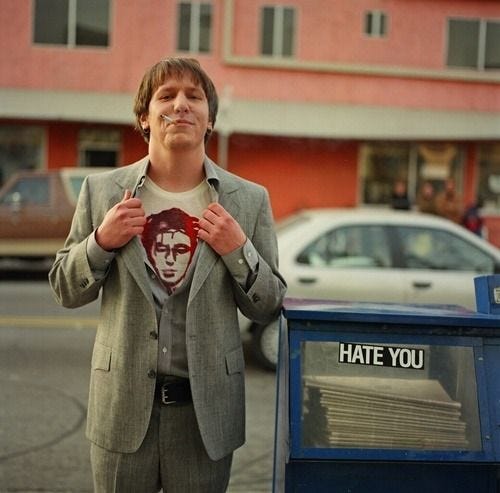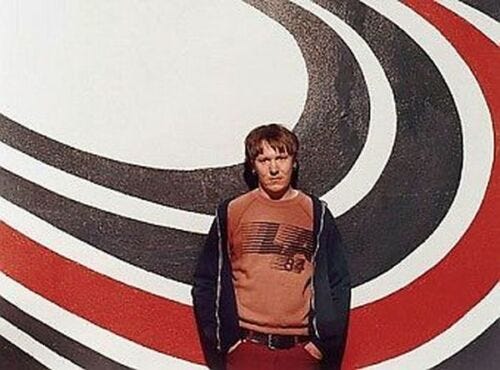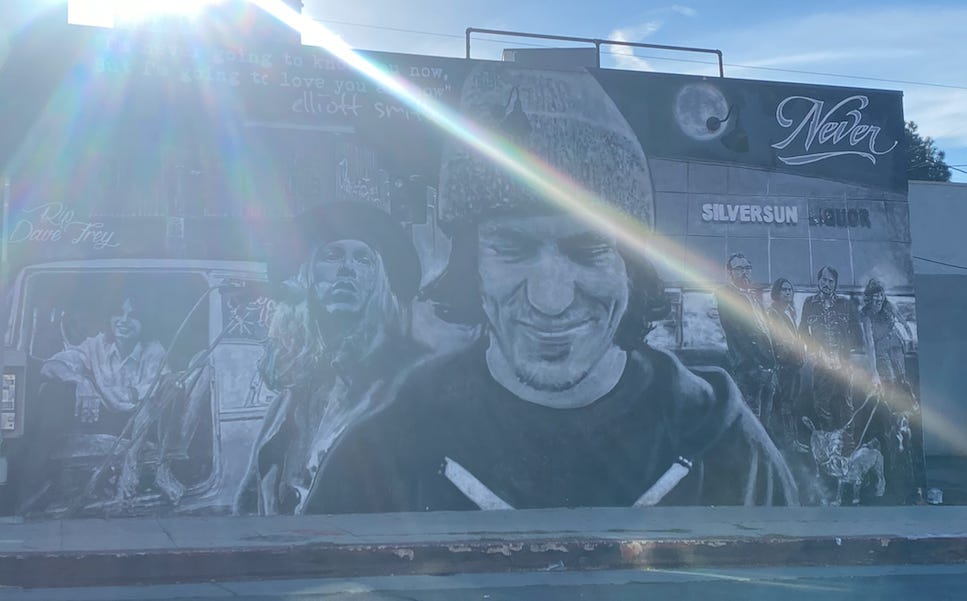*This author is well aware that the so-called “Eastside” and “East Los Angeles” are two very different areas, geographically and demographically, unlike Leonardo DiCaprio. For better or worse, the West and East sides now refer to either side of Hollywood, rather than Downtown, the latter consisting (mostly) of East Hollywood, Los Feliz, Silver Lake, and Echo Park. Thank you.*

So glad to meet you, Angeles.
Although he had major roots in Texas and Oregon, Elliott Smith would make Los Angeles his home for the later part of his life, leaving a lasting mark along Sunset and its tributaries.
Of course, the most famous of these locations is the “Elliott Smith Wall,” a colorful, curvy mural adorning Solutions, an audio equipment repair shop that’s been around for decades. I once had the pleasure of meeting the owner Stephon and hearing his eccentric philosophies of sound while my roommate had some hi-fi speakers fixed. The wall became known to Smith fans after a portrait of him in front of it, taken by Autumn de Wilde, was used for the cover of his album Figure 8.
After Smith’s death, the wall became his de facto memorial, collecting tributes scrawled in Sharpie, candles, and flowers, sometimes a bottle or two of Mad Dog. Unfortunately, four years ago the guys behind Cafe Birdie and Good Housekeeping cut two huge chunks out of the wall for another unremarkable establishment. After some local outcry, they decided to name it Bar Angeles as a nod to Smith, and hung the squares they removed on an interior wall. “Bar Angeles” would close less than a year later, becoming “Ma’am Sir,” by the same owners. So much for appeasement. That restaurant would also close. Today it is a sushi spot. I wonder if the previous owners kept the mural slabs. My gut says they likely threw them out or are holding on, waiting for them to appreciate in value so they can sell them in some soon-to-be vanished art gallery that’s taken over some other special place in the city.
Not too far away, in Atwater Village, is a beloved “dive bar” called The Roost. I use the scare quotes as it’s been remodeled recently and the clientele continues to evolve and scale levels of wealth and yuppie-ness, but at one point it was definitely a dive. The (now digital) jukebox used to have two Smith CDs in rotation. My friend Jamie once pointed out how wonderful it once was to be able to sit in a dark bar and drink where he drank while listening to a song he wrote about the dark bar you’re currently sitting in, on a mechanical juke no less (“In The Lost and Found”).
Making our way back over the river into Walt Disney’s Los Feliz, we come to a very storied set of bungalows: the Snow White Cottages. An apparent visual influence for the famed Disney film, as well as housing for some of the animators during that time as the original Disney Hyperion Studios was just next door, the bungalow court on Griffith Park Boulevard is also widely known as the residence of Diane Selwyn in David Lynch’s Mulholland Drive. Smith lived in two different cottages here sometime in the late ‘90s/early ‘00s.
According to the owner, Sylvia Helfert, who bought the eight cottages in 1976, Smith had a particularly unique bungalow. Helfert cut a big circular hole in his ceiling to install a spiral staircase connecting to the attic. And in that attic? A giant clawfoot bathtub. Apparently Smith wrote many songs in said tub, and since Helfert didn’t acquire permits to make the renovation, Smith would hang a “no trespassing” sign on his door to keep city inspectors out. Eventually, Helfert would apply for a historic designation of the property and remove the staircase and patch the hole. The tub, however, is still in the attic.
Back in Silver Lake, there’s another mural important to Smith’s fans. This one, painted on the side of a now-closed barbershop, the old Sun Lake Drug building, has Elliott front and center, bookended by Beck and the Silversun Pickups (the mural is catty corner from the once-named Silversun Liquor from which they took their name). Originally, the mural had the Eagles of Death Metal in place of Beck—the owner threatened to have the mural painted over if the artist, Jonas Never, didn’t replace the band because of Jesse Hughes’ controversial remarks regarding the deadly terrorist attack at their show at the Bataclan Theatre in Paris.
The mural is on Parkman across the street from beloved local spot Cafe Tropical, which is directly beside Silverlake Lounge where Smith would regularly perform. Elliott is smiling with his eyes closed, though sometimes, to me, it seems like he’s weeping. It isn’t lost on me the parallels I, as a fan and ex-heroin addict, line up to his life, especially here in L.A., like walking down “Alameda” to cop on Skid Row. On more than one occasion, I walked out of an N.A. meeting there in the back of Cafe Tropical, into the bright sunlight with wet eyes, to immediately meet his face. To me, it’s a comfort.
Smith died of two stab wounds to the chest on October 21st, 2003, in the Echo Park home of his girlfriend, Jennifer Chiba, whom he was living with at the time. It remains disputed today whether it was a suicide or homicide. The house is located on Lemoyne, just a bit north of Effie.
It’s interesting that he would write songs in the attic of his Los Feliz bungalow and would finish his career writing songs here, From a Basement on the Hill.
As tragic as a figure Smith was, or is remembered to be, it does make me happy that at the end of his life, when he was 34 as I am now, he would wake up most days and leave the house to be met with this wonderful view of the city we both loved.















I don’t think he loved LA